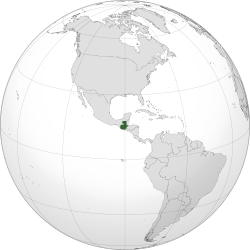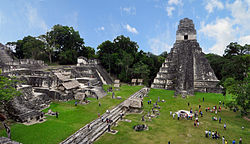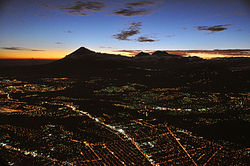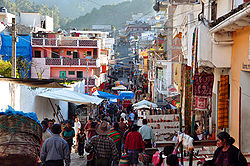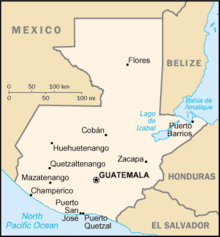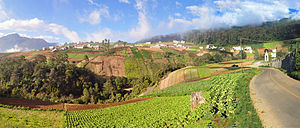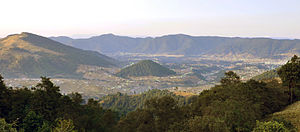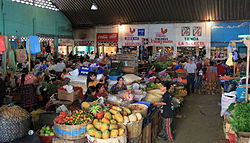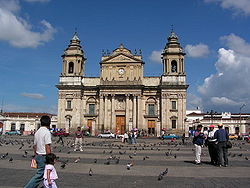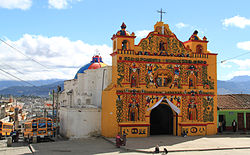
Guatemala
Background to the schools Wikipedia
SOS Children made this Wikipedia selection alongside other schools resources. Child sponsorship helps children one by one http://www.sponsor-a-child.org.uk/.
| Republic of Guatemala República de Guatemala
|
||||||
|---|---|---|---|---|---|---|
|
||||||
Motto:
|
||||||
| Anthem: Himno Nacional de Guatemala National anthem of Guatemala |
||||||
|
|
||||||
| Capital and largest city |
Guatemala City 14°38′N 90°30′W |
|||||
| Official languages | Spanish | |||||
| Ethnic groups (2001) |
|
|||||
| Demonym | Guatemalan | |||||
| Government | Unitary presidential constitutional republic | |||||
| - | President | Otto Pérez Molina | ||||
| - | Vice President | Roxana Baldetti | ||||
| Legislature | Congress of the Republic | |||||
| Independence from Spain | ||||||
| - | Declared | 15 September 1821 | ||||
| - | Declared from the First Mexican Empire |
1 July 1823 | ||||
| - | Current constitution | 31 May 1985 | ||||
| Area | ||||||
| - | Total | 108,889 km2 ( 107th) 42,042 sq mi |
||||
| - | Water (%) | 0.4 | ||||
| Population | ||||||
| - | July 2011 estimate | 13,824,463 ( 69th) | ||||
| - | July 2007 census | 12,728,111 | ||||
| - | Density | 129/km2 ( 85th) 348.6/sq mi |
||||
| GDP ( PPP) | 2011 estimate | |||||
| - | Total | $74.709 billion | ||||
| - | Per capita | $5,069 | ||||
| GDP (nominal) | 2011 estimate | |||||
| - | Total | $46.897 billion | ||||
| - | Per capita | $3,182 | ||||
| Gini (2007) | 55.1 high |
|||||
| HDI (2011) | medium · 131st |
|||||
| Currency | Quetzal ( GTQ) |
|||||
| Time zone | CST ( UTC−6) | |||||
| Drives on the | right | |||||
| Calling code | +502 | |||||
| ISO 3166 code | GT | |||||
| Internet TLD | .gt | |||||
Guatemala (US / ˌ ɡ w ɑː t ə ˈ m ɑː l ə / GWAH-tə-MAH-lə, UK / ˌ ɡ w æ t ɪ ˈ m ɑː l ə / GWA-ti-MAH-lə), officially the Republic of Guatemala (Spanish: República de Guatemala [reˈpuβlika ðe ɣwateˈmala]), is a country in Central America bordered by Mexico to the north and west, the Pacific Ocean to the southwest, Belize to the northeast, the Caribbean to the east, and Honduras and El Salvador to the southeast. Its area is 108,890 km2 (42,043 mi2) with an estimated population of 13,276,517.
A representative democracy, its capital is Nueva Guatemala de la Asunción, also known as Guatemala City. The former Mayan civilization was a Mesoamerican civilization, which continued throughout the Post-Classic period until the arrival of the Spanish. They had lived in Guatemala, Honduras, Belize, the southern part of Mexico and eastern parts of El Salvador.
Guatemala's abundance of biologically significant and unique ecosystems contributes to Mesoamerica's designation as a biodiversity hotspot.
Guatemala became independent from Spain in 1821. After independence it was ruled by a series of dictators, assisted by the United Fruit Company and the United States government. From 1960 to 1996, Guatemala underwent a civil war fought between the government and leftist rebels. Following the war, Guatemala has witnessed both economic growth and successful democratic elections. In the most recent election, held in 2011, Otto Pérez Molina of the Patriotic Party won the presidency.
Etymology
The name "Guatemala" comes from Nahuatl Cuauhtēmallān, "place of many trees", a translation of K'iche' Mayan K'iche' , "many trees". This was the name the Tlaxcaltecan soldiers who accompanied Pedro de Alvarado during the Spanish Conquest gave to this territory.
History
Pre-Columbian
The first evidence of human settlers in Guatemala dates back to 12,000 BC. Some evidence suggests human presence as early as 18,000 BC, such as obsidian arrow heads found in various parts of the country. There is archaeological proof that early Guatemalan settlers were hunters and gatherers, but pollen samples from Petén and the Pacific coast indicate that maize cultivation was developed by 3500 BC. Sites dating back to 6500 BC have been found in Quiché in the Highlands and Sipacate, Escuintla on the central Pacific coast.
Archaeologists divided the pre-Columbian history of Mesoamerica into the Preclassic period (2999 BC to 250 BC), the Classic period (250 to 900 AD), and the Postclassic from 900 to 1500 AD. Until recently the Pre-Classic was regarded as a formative period, with small villages of farmers who lived in huts, and few permanent buildings. However, this notion has been challenged by recent discoveries of monumental architecture from that period, such as an altar in La Blanca, San Marcos, from 1000 BC; ceremonial sites at Miraflores and El Naranjo from 801 BC; the earliest monumental masks; and the Mirador Basin cities of Nakbé, Xulnal, El Tintal, Wakná and El Mirador.
Both the El Tigre and Monos pyramids encompass a volume greater than 250,000 cubic meters, and the city lay at the centre of a populous and well-integrated region.
The Classic period of Mesoamerican civilization corresponds to the height of the Maya civilization, and is represented by countless sites throughout Guatemala, although the largest concentration is in Petén. This period is characterized by heavy city-building, the development of independent city-states, and contact with other Mesoamerican cultures.
This lasted until around 900 AD, when the Classic Maya civilization collapsed. The Maya abandoned many of the cities of the central lowlands or were killed off by a drought-induced famine. Scientists debate the cause of the Classic Maya Collapse, but gaining currency is the Drought Theory discovered by physical scientists studying lakebeds, ancient pollen, and other tangible evidence. A series of prolonged droughts, among other reasons (such as overpopulation), in what is otherwise a seasonal desert is thought to have decimated the Maya, who were primarily reliant upon regular rainfall.
The Post-Classic period is represented by regional kingdoms, such as the Itza, Ko'woj, Yalain and Kejache in Petén, and the Mam, Ki'che', Kackchiquel, Chajoma, Tz'utujil, Poqomchi', Q'eqchi' and Ch'orti' in the Highlands. Their cities preserved many aspects of Mayan culture, but would never equal the size or power of the Classic cities.
The Maya civilization shares many features with other Mesoamerican civilizations due to the high degree of interaction and cultural diffusion that characterized the region. Advances such as writing, epigraphy, and the calendar did not originate with the Maya; however, their civilization fully developed them. Maya influence can be detected from Honduras, Guatemala, Northern El Salvador and to as far as central Mexico, more than 1,000 km (620 mi) from the Maya area. Many outside influences are found in Maya art and architecture, which are thought to result from trade and cultural exchange rather than direct external conquest.
Colonial (1519-1821)
After arriving in what was named the New World, the Spanish started several expeditions to Guatemala, beginning in 1519. Before long, Spanish contact resulted in an epidemic that devastated native populations. Hernán Cortés, who had led the Spanish conquest of Mexico, granted a permit to Captains Gonzalo de Alvarado and his brother, Pedro de Alvarado, to conquer this land. Alvarado at first allied himself with the Kaqchikel nation to fight against their traditional rivals the K'iche' (Quiché) nation. Alvarado later turned against the Kaqchikel, and eventually held the entire region under Spanish domination. Several families of Spanish descent subsequently rose to prominence in colonial Guatemala, including the surnames de Arrivillaga, Arroyave, Alvarez de las Asturias, González de Batres, Coronado, Gálvez Corral, Mencos, Delgado de Nájera, de la Tovilla, and Varón de Berrieza.
During the colonial period, Guatemala was an Audiencia and a Captaincy General ( Capitanía General de Guatemala) of Spain, and a part of New Spain (Mexico). The first capital was named Tecpan Guatemala, founded on July 25, 1524 with the name of Villa de Santiago de Guatemala and was located near Iximché, the Kaqchikel capital city. It was moved to Ciudad Vieja on November 22, 1527, when the Kaqchikel attacked the city. On September 11, 1541 the city was flooded when the lagoon in the crater of the Agua Volcano collapsed due to heavy rains and earthquakes, and was moved 4 miles (6 km) to Antigua Guatemala, on the Panchoy Valley, now a UNESCO World Heritage Site. This city was destroyed by several earthquakes in 1773–1774, and the King of Spain granted the authorization to move the capital to the Ermita Valley, named after a Catholic church to the Virgen de El Carmen, in its current location, founded on January 2, 1776.
Independence and the 19th century
On September 15, 1821, the Captaincy-general of Guatemala (formed by Chiapas, Guatemala, El Salvador, Nicaragua, Costa Rica, and Honduras) officially proclaimed its independence from Spain which was dissolved two years later. This region had been formally subject to New Spain throughout the colonial period, but as a practical matter was administered separately. It was not until 1825 that Guatemala created its own flag.
The Guatemalan provinces formed the United Provinces of Central America, also called the Central American Federation (Federacion de Estados Centroamericanos), which dissolved in civil war from 1838 to 1840. Guatemala's Rafael Carrera was instrumental in leading the revolt against the federal government and breaking apart the Union. During this period a region of the Highlands, Los Altos, declared independence from Guatemala, but was annexed by Carrera, who dominated Guatemalan politics until 1865, backed by conservatives, large land owners and the church.
Guatemala's "Liberal Revolution" came in 1871 under the leadership of Justo Rufino Barrios, who worked to modernize the country, improve trade, and introduce new crops and manufacturing. During this era coffee became an important crop for Guatemala. Barrios had ambitions of reuniting Central America and took the country to war in an unsuccessful attempt to attain it, losing his life on the battlefield in 1885 against forces in El Salvador.
From 1898 to 1920, Guatemala was ruled by the dictator Manuel Estrada Cabrera, whose access to the presidency was helped by the United Fruit Company. It was during his long presidency that the United Fruit Company became a major force in Guatemala.
1944 to the end of the civil war
On July 4, 1944, dictator Jorge Ubico Castañeda was forced to resign his office in response to a wave of protests and a general strike. His replacement, General Juan Federico Ponce Vaides, was later also forced out of office on October 20, 1944 by a coup d'état led by Major Francisco Javier Arana and Captain Jacobo Arbenz Guzmán. About 100 people were killed in the coup. The country was led by a military junta made up of Arana, Arbenz, and Jorge Toriello Garrido.
The Junta called Guatemala's first free election, which was won with a majority of 85% by the prominent writer and teacher Juan José Arévalo Bermejo, who had lived in exile in Argentina for 14 years. Arévalo was the first democratically elected president of Guatemala to fully complete the term for which he was elected. His " Christian Socialist" policies, inspired by the U.S. New Deal, were criticized by landowners and the upper class as "communist."
Arévalo was succeeded by Jacobo Árbenz Guzmán, who was elected in 1951. Árbenz adopted a major land reform policy called Decree 900, which ordered redistribution of uncultivated lands—thereby increasing production of crops and providing many peasants with income. His popular program of land reform, credit, and literacy began to diminish the extreme inequality in Guatemala, although the process of redistributing land created some conflicts.
Árbenz was overthrown in a coup orchestrated by the U.S. Central Intelligence Agency (CIA). After his land reform, the CIA intervened because it feared that a socialist government would become a Soviet beachhead in the Western Hemisphere. It has also been alleged that intervened to protect the property of the United Fruit Company (later Chiquita Brands International Inc.) that was under threat from the land reform. Carlos Castillo Armas, a former military officer who led the CIA-backed invasion from Honduras, was installed as president in 1954. Castillo reversed Decree 900 and ruled until he was assassinated by a member of his personal guard in 1957. The Cold War between the U.S. and the USSR continued to exert influence on Guatemalan history—including direct effects such as support of Guatemala's army into the 1990s.
In the election that followed, General Miguel Ydígoras Fuentes assumed power. He is most celebrated for challenging the Mexican president to a gentleman's duel on the bridge on the south border to end a feud on the subject of illegal fishing by Mexican boats on Guatemala's Pacific coast, two of which were sunk by the Guatemalan Air Force. Ydigoras authorized the training of 5,000 anti-Castro Cubans in Guatemala. He also provided airstrips in the region of Petén for what later became the failed Bay of Pigs Invasion in 1961. Ydigoras' government was ousted in 1963 when the Guatemalan Air Force attacked several military bases. The coup was led by his Defense Minister, Colonel Enrique Peralta Azurdia.
In 1966, Julio César Méndez Montenegro was elected president of Guatemala under the banner "Democratic Opening". Mendez Montenegro was the candidate of the Revolutionary Party, a centre-left party which had its origins in the post-Ubico era. It was during this time that rightist paramilitary organizations, such as the "White Hand" ( Mano Blanca), and the Anticommunist Secret Army, (Ejército Secreto Anticomunista), were formed. Those organizations were the forerunners of the infamous " Death Squads". Military advisers from the United States Army Special Forces (Green Berets) were sent to Guatemala to train troops and help transform its army into a modern counter-insurgency force, which eventually made it the most sophisticated in Central America.
In 1970, Colonel Carlos Manuel Arana Osorio was elected president. A new guerrilla movement entered the country from Mexico, into the Western Highlands in 1972. In the disputed election of 1974, General Kjell Laugerud García defeated General Efraín Ríos Montt, a candidate of the Christian Democratic Party, who claimed that he had been cheated out of a victory through fraud. On February 4, 1976, a major earthquake destroyed several cities and caused more than 25,000 deaths. In 1978, in a fraudulent election, General Romeo Lucas García assumed power.
The 1970s saw the birth of two new guerrilla organizations, The Guerrilla Army of the Poor (EGP) and the Organization of the People in Arms (ORPA), who began and intensified by the end of the seventies, guerrilla attacks that included urban and rural guerrilla warfare, mainly against the military and some of the civilian supporters of the army. In 1979, the U.S. president, Jimmy Carter, ordered a ban on all military aid to the Guatemalan Army because of the widespread and systematic abuse of human rights.
In 1980, a group of indigenous K'iche' took over the Spanish Embassy to protest army massacres in the countryside. The Guatemalan government launched an assault that killed almost everyone inside as a result of a fire that consumed the building. The Guatemalan government claimed that the activists set the fire and immolated themselves. However, the Spanish ambassador, who survived the fire, disputed this claim, claiming that the Guatemalan police intentionally killed almost everyone inside and set the fire to erase traces of their acts. As a result of this incident, the government of Spain broke diplomatic relations with Guatemala.
This government was overthrown in 1982. General Ríos Montt was named President of the military junta, continuing the bloody campaign of torture, forced disappearances, and " scorched earth" warfare. The country became a pariah state internationally. Ríos Montt was overthrown by General Óscar Humberto Mejía Victores, who called for an election of a national constitutional assembly to write a new constitution, leading to a free election in 1986, which was won by Vinicio Cerezo Arévalo, the candidate of the Christian Democracy Party.
In 1982, the four guerrilla groups, EGP, ORPA, FAR and PGT, merged and formed the URNG, influenced by the Salvadoran guerrilla FMLN, the Nicaraguan FSLN and Cuba's government, in order to become stronger. As a result of the Army's "scorched earth" tactics in the countryside, more than 45,000 Guatemalans fled across the border to Mexico. The Mexican government placed the refugees in camps in Chiapas and Tabasco.
In 1992, the Nobel Peace Prize was awarded to Rigoberta Menchú for her efforts to bring international attention to the government-sponsored genocide against the indigenous population.
Since 1996
The Guatemalan Civil War ended in 1996 with a peace accord between the guerrillas and the government, negotiated by the United Nations through intense brokerage by nations such as Norway and Spain. Both sides made major concessions. The guerrilla fighters disarmed and received land to work. According to the U.N.-sponsored truth commission the (" Commission for Historical Clarification"), government forces and state-sponsored paramilitaries were responsible for over 93 percent of the human rights violations during the war.
Over the last few years, millions of documents related to crimes committed during the civil war were found abandoned by the former Guatemalan police. Among millions of documents found, there was evidence that the former police chief of Guatemala, Hector Bol de la Cruz had been involved in the kidnapping and murder of 27-year-old student Fernando Garcia in 1984. The evidence was used to prosecute the former police chief. The families of over 45,000 Guatemalan activists are now reviewing the documents (which have been digitized) and this could lead to further legal actions. Paradoxically, the current democratically elected president, Otto Pérez Molina, could be a barrier to further legal action as he, a retired general, was the head of intelligence in Guatemala during the civil war.
During the first ten years, the victims of the state-sponsored terror were primarily students, workers, professionals, and opposition figures, but in the last years they were thousands of mostly rural Mayan farmers and non-combatants. More than 450 Mayan villages were destroyed and over 1 million people became displaced within Guatemala or refugees. Over 200,000 people, mostly Mayan, lost their lives during the civil war.
In certain areas, such as Baja Verapaz, the Truth Commission considered that the Guatemalan state engaged in an intentional policy of genocide against particular ethnic groups in the Civil War. In 1999, U.S. president Bill Clinton stated that the United States was wrong to have provided support to Guatemalan military forces that took part in the brutal civilian killings.
Since the peace accords, Guatemala has witnessed both economic growth and successive democratic elections, most recently in 2011. In the 2011 elections, Otto Pérez Molina of the Patriotic Party, won the presidency. He assumed office on January 14, 2012. He named Roxana Baldetti as his vice president.
On January 12, 2012, Efrain Rios Montt, former President of Guatemala during the military dictatorship, appeared in a Guatemalan court on genocide charges. During the hearing, the government presented evidence of over 100 incidents involving at least 1,771 deaths, 1,445 rapes, and the displacement of nearly 30,000 Guatemalans during his 17-month rule from 1982-1983, according to the Washington Post, BBC, Siglo XXI (in Spanish), and the LA Times. The prosecution wanted him incarcerated because of his potential for flight but the judge ruled that he can remain out on bail. He has now been placed under house arrest and will be watched by the Guatemalan National Civil Police (PNC). The trial, now under way, is expected to last at least a year.
The estimated median age in Guatemala is 20 years old, 19.4 for males and 20.7 years for females. This is the lowest median age of any country in the Western Hemisphere and comparable to most of central Africa and Iraq.
Governance
Political system
Guatemala is a constitutional democratic republic whereby the President of Guatemala is both head of state and head of government, and of a multi-party system. Executive power is exercised by the government. Legislative power is vested in both the government and the Congress of the Republic. The judiciary is independent of the executive and the legislature.
Otto Perez Molina is the current President of Guatemala.
Departments and municipalities
Guatemala is divided into 22 departments (departamentos) and sub-divided into about 334 municipalities (municipios).
The departments are:
Guatemala is heavily centralized. Transportation, communications, business, politics, and the most relevant urban activity takes place in Guatemala City. Guatemala City has about 2 million inhabitants within the city limits and more than 5 million within the urban area. This is a significant percentage of the population (14 million).
Geography
Guatemala lies between latitudes 13° and 18°N, and longitudes 88° and 93°W.
The country is mountainous with small desert and sand dune patches, hilly valleys, except for the south coastal area and the vast northern lowlands of Petén department. Two mountain chains enter Guatemala from west to east, dividing the country into three major regions: the highlands, where the mountains are located; the Pacific coast, south of the mountains; and the Petén region, north of the mountains. All major cities are located in the highlands and Pacific coast regions; by comparison, Petén is sparsely populated. These three regions vary in climate, elevation, and landscape, providing dramatic contrasts between hot, humid tropical lowlands and colder, drier highland peaks. Volcán Tajumulco, at 4,220 m, is the highest point in the Central American states.
The rivers are short and shallow in the Pacific drainage basin, larger and deeper in the Caribbean and the Gulf of Mexico drainage basins, which include the Polochic and Dulce Rivers, which drain into Lake Izabal, the Motagua River, the Sarstún that forms the boundary with Belize, and the Usumacinta River, which forms the boundary between Petén and Chiapas, Mexico.
Guatemala has long claimed all or part of the territory of neighboring Belize, currently an independent Commonwealth Realm which recognises Queen Elizabeth II as its Head of State. Due to this territorial dispute, Guatemala recognized Belize's independence until 1990, but the dispute is not resolved. Negotiations are currently underway under the auspices of the Organization of American States and the Commonwealth of Nations to conclude it.
Natural disasters
Guatemala's location between the Caribbean Sea and Pacific Ocean makes it a target for hurricanes, such as Hurricane Mitch in 1998 and Hurricane Stan in October 2005, which killed more than 1,500 people. The damage was not wind related, but rather due to significant flooding and resulting mudslides. The most recent was Tropical Storm Agatha in late May 2010 that killed more than 200.
Guatemala's highlands lie along the Motagua Fault, part of the boundary between the Caribbean and North American tectonic plates. This fault has been responsible for several major earthquakes in historic times, including a 7.5 magnitude tremor on February 4, 1976, which killed more than 25,000 people. In addition, the Middle America Trench, a major subduction zone lies off the Pacific coast. Here, the Cocos Plate is sinking beneath the Caribbean Plate, producing volcanic activity inland of the coast. Guatemala has 37 volcanoes, four of them are active: Pacaya, Santiaguito, Fuego and Tacaná. Fuego and Pacaya erupted in 2010.
Natural disasters have a long history in this geologically active part of the world. For example, two of the three moves of the capital of Guatemala have been due to volcanic mudflows in 1541 and earthquakes in 1773.
Pacaya
On Thursday May 27, 2010, the Pacaya volcano started erupting lava and rocks, blanketing Guatemala City with black sand (and forcing the closure of the international airport). It was declared a "state of calamity." The Pacaya volcano left about 8 cm (3 in) of ash and sand through all of Guatemala City. Cleaning works are done.
Biodiversity
The country has 14 ecoregions ranging from mangrove forests to both ocean littorals with 5 different ecosystems. Guatemala has 252 listed wetlands, including 5 lakes, 61 lagoons, 100 rivers, and 4 swamps. Tikal National Park was the first mixed UNESCO World Heritage Site. Guatemala is a country of distinct fauna. It has some 1246 known species. Of these, 6.7% are endemic and 8.1% are threatened. Guatemala is home to at least 8681 species of vascular plants, of which 13.5% are endemic. 5.4% of Guatemala is protected under IUCN categories I-V.
In the department of Petén lies the Maya Biosphere Reserve of 2,112,940 ha, making it the second largest forest in Central America after Bosawas.
Demographics
According to the CIA World Fact Book, Guatemala has a population of 13,824,463 (2011 est). About 59% of the population is Ladino, also called Mestizo and European (mixed Amerindian and Spanish). Amerindian populations include the K'iche' 9.1%, Kaqchikel 8.4%, Mam 7.9% and Q'eqchi 6.3%. 8.6% of the population is "other Mayan," 0.4% is indigenous non-Mayan, making the indigenous community in Guatemala about 40.5% of the population.
There are smaller communities present. The Garífuna, who are descended primarily from Black Africans who lived with and intermarried with indigenous peoples from St. Vincent, live mainly in Livingston and Puerto Barrios. Those communities have other blacks and mulattos descended from banana workers. There are also Asians, mostly of Chinese descent. Other Asian groups include Arabs of Lebanese and Syrian descent. There is also a growing Korean community in Guatemala City and in nearby Mixco, currently numbering about 10,000. Guatemala's German population is credited with bringing the tradition of a Christmas tree to the country.
In 1900, Guatemala had a population of 885,000. Over the course of the twentieth century the population of the country grew, the fastest growth in the Western Hemisphere. The ever-increasing pattern of immigration to the U.S. has led to the growth of Guatemalan communities in California, Florida, Illinois, New York, Texas, Rhode Island and elsewhere since the 1970s.
Largest cities
Diaspora
The Civil War forced many Guatemalans to start lives outside of their country. The majority of the Guatemalan diaspora is located in the United States, with estimates ranging from 480,665 to 1,489,426. The difficulty in getting accurate counts for Guatemalans abroad is because many of them are refugee claimants awaiting determination of their status. Below are estimates for certain countries:
| Country | Count |
|---|---|
| 480,665 – 1,489,426 | |
| 23,529 – 190,000 | |
| 14,693 | |
| 14,256 – 34,665 | |
| 5,989 | |
| 5,172 | |
| 4,209 | |
| 2,491 – 5,000 |
Economy
According to the CIA World Factbook, Guatemala's GDP (PPP) per capita is US$5,200; however, this developing country still faces many social problems and is one of the poorest countries in Latin America. The distribution of income remains highly unequal with more than half of the population below the national poverty line and just over 400,000 (3.2%) unemployed. The CIA World Fact Book considers 56.2% of the population of Guatemala to be living in poverty.
Remittances from Guatemalans who fled to the United States during the civil war now constitute the largest single source of foreign income (two thirds of exports and one tenth of GDP).
In recent years the exporter sector of nontraditional products has grown dynamically representing more than 53% of global exports. Some of the main products for export are fruits, vegetables, flowers, handicrafts, cloths and others. In the face of a rising demand for biofuels, the country is growing and exporting an increasing amount of raw materials for biofuel production, especially sugar cane and palm oil. Critics say that this development leads to higher prices of staple foods like corn, a major ingredient in the Guatemalan diet. As a consequence of the subsidization of US American corn, Guatemala imports nearly half of its corn from the United States that is using 40 percent of its crop harvest for biofuel production.
Gross Domestic Product (GDP) in purchasing power parity (PPP) in 2010 was estimated at $70.15 billion USD. The service sector is the largest component of GDP at 63%, followed by the industry sector at 23.8% and the agriculture sector at 13.2% (2010 est.). Mines produce gold, silver, zinc, cobalt and nickel. The agricultural sector accounts for about two-fifths of exports, and half of the labor force. Organic coffee, sugar, textiles, fresh vegetables, and bananas are the country's main exports. Inflation was 3.9% in 2010.
The 1996 peace accords that ended the decades-long civil war removed a major obstacle to foreign investment. Tourism has become an increasing source of revenue for Guatemala.
In March 2006, Guatemala's congress ratified the Dominican Republic – Central American Free Trade Agreement (DR-CAFTA) between several Central American nations and the United States. Guatemala also has free trade agreements with Taiwan and Colombia.
Culture
Guatemala City is home to many of the nation's libraries and museums, including the National Archives, the National Library, and the Museum of Archeology and Ethnology, which has an extensive collection of Maya artifacts. There are private museums, such as the Ixchel, which focuses on textiles, and the Popol Vuh, which focuses on Maya archaeology. Both museums are housed inside the Universidad Francisco Marroquín campus. Almost each of the 329 municipalities in the country has a small museum.
Art
Guatemala has produced many indigenous artists who follow centuries-old Pre-Columbian traditions. However, reflecting Guatemala's colonial and post-colonial history, encounters with multiple global art movements also have produced a wealth of artists who have combined the traditional so-called "primitivism" or "naive" aesthetic with European, North American, and other traditions. The Escuela Nacional de Artes Plásticas "Rafael Rodríguez Padilla" is the country's leading art school, and several leading indigenous artists, also graduates of that school, are in the permanent collection of the Museo Nacional de Arte Moderno in the capital city. Contemporary Guatemalan artists who have gained reputations outside of Guatemala include Dagoberto Vásquez, Luis Rolando Ixquiac Xicara, Carlos Mérida, Aníbal López, Roberto González Goyri, and Elmar René Rojas.
Literature
The Guatemala National Prize in Literature is a one-time only award that recognizes an individual writer's body of work. It has been given annually since 1988 by the Ministry of Culture and Sports.
Miguel Ángel Asturias won the literature Nobel Prize in 1967. Among his famous books is El Señor Presidente, a novel based on the government of Manuel Estrada Cabrera.
Rigoberta Menchu, winner of the Nobel Peace Prize for fighting oppression of indigenous people in Guatemala, is famous for her books I, Rigoberta Menchu and Crossing Borders.
Music
The music of Guatemala comprises a number of styles and expressions. Guatemalan social change has been empowered by music scenes such as Nueva cancion, which blends together histories, present day issues, and the political values and struggles of common people. The Maya had an intense musical practice, as is documented by iconography. Guatemala was also one of the first regions in the New World to be introduced to European music, from 1524 on. Many composers from the Renaissance, baroque, classical, romantic, and contemporary music styles have contributed works of all genres. The marimba is the national instrument that has developed a large repertoire of very attractive pieces that have been popular for more than a century.
The Historia General de Guatemala has published a series of CDs of historical music of Guatemala, in which every style is represented, from the Maya, colonial period, independent and republican eras to current times. There are many contemporary music groups in Guatemala from Caribbean music, salsa, punta ( Garifuna influenced), Latin pop, Mexican regional, and mariachi.
Cuisine
Many traditional foods in Guatemalan cuisine are based on Maya cuisine and prominently feature corn, chilies and beans as key ingredients. There are also foods that are commonly eaten on certain days of the week. For example, it is a popular custom to eat paches (a kind of tamale made from potatoes) on Thursday. Certain dishes are also associated with special occasions, such as fiambre for All Saints Day on November 1 and tamales, which are common around Christmas.
Language

Although Spanish is the official language, it is not universally spoken among the indigenous population, nor is it often spoken as a second language by the elderly indigenous. Twenty-one Mayan languages are spoken, especially in rural areas, as well as two non-Mayan Amerindian dialects, Xinca, an indigenous dialect, and Garifuna, an Arawakan dialect spoken on the Caribbean coast. According to Decreto Número 19-2003, twenty-three dialects are unrecognized as National Languages.
As a first and second language, Spanish is spoken by 93% of the population.
The peace accords signed in December 1996 provide for the translation of some official documents and voting materials into several indigenous languages (see summary of main substantive accords) and mandate the provision of interpreters in legal cases for non-Spanish speakers. The accord also sanctioned bilingual education in Spanish and indigenous languages. It is common for indigenous Guatemalans to learn or speak between two to five of the nation's other languages, and Spanish.
Religion
50–60% of the Guatemalan population is Catholic, 40% Protestant, 3% Eastern Orthodox and 1% follow the indigenous Mayan faith. Catholicism was the official religion during the colonial era. However, the practice of Protestantism has increased markedly in recent decades. More than one third of Guatemalans are Protestant, chiefly Evangelicals and Pentecostals. It is common for relevant Mayan practices to be incorporated into Catholic ceremonies and worship when they are sympathetic to the meaning of Catholic belief; this phenomenon is known as inculturation. The practice of traditional Mayan religion is increasing as a result of the cultural protections established under the peace accords. The government has instituted a policy of providing altars at every Mayan ruin found in the country so that traditional ceremonies may be performed there.
There are also small communities of Jews estimated between 1200 and 2000, Muslims (1200), Buddhists at around 9000 to 12000, and members of other faiths and those who do not profess any faith.
The Church of Jesus Christ of Latter-day Saints currently has over 215,000 members in Guatemala, accounting for approximately 1.65% of the country's estimated population in 2008. The first member of the LDS Church in Guatemala was baptized in 1948. Membership grew to 10,000 by 1966, and 18 years later, when the Guatemala City Temple was dedicated in 1984, membership had risen to 40,000. By 1998 membership had quadrupled again to 164,000. The LDS Church continues to grow in Guatemala; it has announced and begun the construction of the Quetzaltenango Guatemala Temple, the LDS Church's second temple in the country.
Recently, it was announced that 520,000 members of the Orthodox Catholic Church of Guatemala (OCCG) were received into communion with the Ecumenical Patriarchate of Constantinople. The OCCG has an approximate membership of 527,000 faithful and catechumens, overwhelmingly indigenous, with 334 churches in Guatemala and southern Mexico, with 12 (formerly OCCG) clergymen and 14 seminarians, who are assisted in their pastoral ministry by 250 lay ministers and 380 catechists. The administrative offices of the OCCG are located on 280 acres (113 ha) of land, with a community college and 2 schools with 12 professors/teachers. Additionally, the OCCG has an established monastery located on 480 acres (194 ha) of land. Fourteen students from Guatemala, with full scholarship, are now enrolled in the St. Gregory Nazianzen Orthodox Theological Institute Licentiate degree program. The seminary is fully accredited by the Holy Metropolis’ Department of Education.
Funeral traditions
When people pass away in Guatemala, they are usually buried as soon as possible, so as to provide a quick passage to heaven. Funerals generally include candles and rum, and despite the local superstition that loud mourning and crying will slow down the deceased's journey to the next world; mourners usually cry very loudly, except at funerals for children. Deceased are buried with their treasured items to dissuade them from returning to haunt the people.
Education
The government runs a number of public elementary and secondary-level schools. These schools are free, though the cost of uniforms, books, supplies, and transportation makes them less accessible to the poorer segments of society and significant numbers of poor children do not attend school. Many middle and upper-class children go to private schools. The country also has one public university (USAC or Universidad de San Carlos de Guatemala), and nine private ones (see List of universities in Guatemala). USAC was one of the first universities in Guatemala. It was officially declared a university on January 31, 1676 by royal command of King Charles II of Spain. Only 74.5% of the population aged 15 and over are literate, the lowest literacy rate in Central America. Although it has the lowest literacy rate, Guatemala is expected to change this within the next 20 years. Organizations such as Child Aid, which trains teachers in villages throughout the Central Highlands region, are working to improve educational outcomes for children. Lack of training for rural teachers is one of the key contributors to the country's low literacy rates.
Health
Medical anthropology and pluralism
In the 1950s, medical anthropologists such as Richard N. Adams, Benjamin D. Paul, and Lois Paul wrote monographs dedicated to the Maya medical beliefs and practices. Richard N. Adams, albeit secondary to his work, described the chasm between Maya medical beliefs and practices and Western science, and showed why Mayans rejected projects applied by the Institute of Nutrition for Central America and Panama (INCAP). His work is seen as setting the stage for four decades for medical anthropology in Guatemala by diagnosing the communication breakdown caused by “ignorance of local beliefs and practices.” Many of those once affiliated with INCAP have since published works on various topics of interest to medical anthropology in Guatemala.
In the 20th century, several things came to undermine the indigenous way of practicing medicine. First, the religious persecution first administered by Catholic Action, then Protestant evangelical religions, and finally by Catholic Charismatics resulted in the prohibition of their members from consulting traditional healers. Secondly, certain elements of Guatemalan society systematically killed the upper rank of the Maya priests. Third, starting in the 1980s, the Guatemalan national health care system, based heavily on Western medicine, began to suppress traditional healers by banning them from practicing. While the health care system made efforts to train local midwives, some persons accused those programs of not giving culturally appropriate, high-quality services.
The disparity between Western biomedicine and traditional care has created tensions, i.e., NGO programs primarily focus today on those with higher education levels—those who speak Spanish—and rivalries hamper communication between Western-trained health care providers and traditional practitioners. Additionally, the medical professionals of Western biomedicine neglect the social experience of the patients, as well as the social construction of disease. Studies conducted in Mexico, Guatemala, and other rural areas support the position that many Western biomedical practitioners shun remote areas either because they cannot earn enough money there or because they discriminate against ethnic minorities.
Today, patients must choose between the two systems based on the complex conditions surrounding the ailment and decide which medical system most likely will provide a cure for their ailment.
Laureates
Rigoberta Menchú won the Nobel Peace prize in 1992 for her very important work in favour of the Mayan people, and the Mayan refugees in Mexico and the US. Miguel Ángel Asturias won the Nobel prize in Literature in 1967 for his entire body of work, including the novel El Señor Presidente, which was controversial during Guatemala's civil war, since it portrayed the horrors of life under authoritarian rule.
Journalism
There are seven national newspapers in TV, some of them being Noti7, Telecentro Trece and Noticiero Guatevision. The Guatemala Times is a digital English news magazine.


